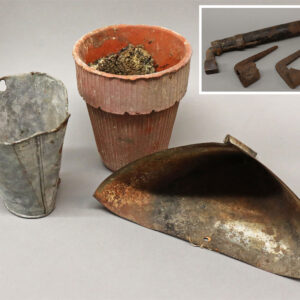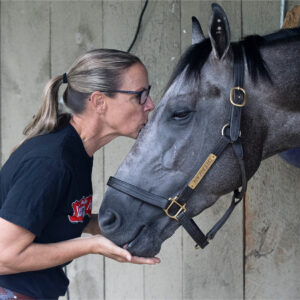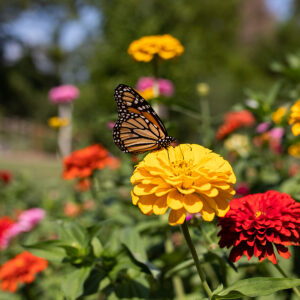Take some time away from the yardwork this month and be inspired by these gardening books, which will delight you with humor, great information and distinctive takes on the joys of growing.
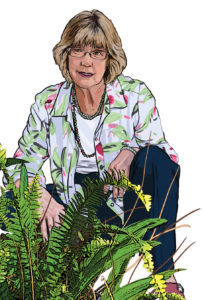
Illustration by Jordan Shapot
Let’s be honest, it’s just too hot to work outside right now, so if you (and your plants) survive August in Florida, well, you deserve a break!
If you manage to get through the heat and humidity, the thunderstorms and the insects, you’ve accomplished a lot, so rest. Reading gardening books can help you learn more about your hobby and inspire you with fresh ideas to try when the weather cools down. Here are a few of my favorites:
 From the Ground Up: The Story of a First Garden, by Amy Stewart. This is a gentle memoir of a young woman’s first journeys into gardening. Stewart was a complete newbie when she moved into a rental house with a small lot in northern California. She details her early mistakes in a way that’s instructive and amusing. When she finally admits to herself that regular houseplants are “boring” and a friend gives her orchids, she’s hooked, likening them to “…foreign exchange students, with far more interesting customs and cuisines than the messy, lumbering American teenagers I had for houseplants before.” For Stewart, gardening was an emotional journey as well as a physical one and this is a lovely read that will have you wanting to get your hands dirty.
From the Ground Up: The Story of a First Garden, by Amy Stewart. This is a gentle memoir of a young woman’s first journeys into gardening. Stewart was a complete newbie when she moved into a rental house with a small lot in northern California. She details her early mistakes in a way that’s instructive and amusing. When she finally admits to herself that regular houseplants are “boring” and a friend gives her orchids, she’s hooked, likening them to “…foreign exchange students, with far more interesting customs and cuisines than the messy, lumbering American teenagers I had for houseplants before.” For Stewart, gardening was an emotional journey as well as a physical one and this is a lovely read that will have you wanting to get your hands dirty.
 The Complete Houseplant Survival Manual, by Barbara Pleasant. This hands-on, how-to is filled with specific tips on many traditional houseplants, formatted for easy reference. Each plant has a specifications section that details requirements for light, water, longevity and propagation. Her troubleshooting sections will help you solve any issues that might arise. She discusses tropicals, succulents, bromeliads and standard houseplants such as pothos, ferns and philodendrons. Best of all are the full-color photos that show each plant in full leaf and flower. I’ve got several pages marked with houseplants I’ve just got to try, such as calathea and a zebra plant. It’s bit pricey due to the color pages and photos, but worth every penny.
The Complete Houseplant Survival Manual, by Barbara Pleasant. This hands-on, how-to is filled with specific tips on many traditional houseplants, formatted for easy reference. Each plant has a specifications section that details requirements for light, water, longevity and propagation. Her troubleshooting sections will help you solve any issues that might arise. She discusses tropicals, succulents, bromeliads and standard houseplants such as pothos, ferns and philodendrons. Best of all are the full-color photos that show each plant in full leaf and flower. I’ve got several pages marked with houseplants I’ve just got to try, such as calathea and a zebra plant. It’s bit pricey due to the color pages and photos, but worth every penny.
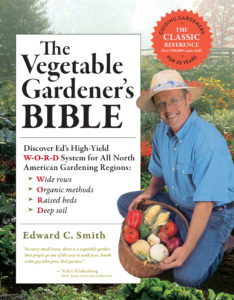 The Vegetable Gardener’s Bible, by Edward C. Smith. I used this book to successfully create, plant and manage 10 raised vegetable beds. One year, I harvested more than 300 pounds of veggies, including green beans, squash, sweet potatoes, onions, various herbs, strawberries, corn and tomatoes and potatoes (which you should not grow near each other because tomato hornworms can devastate potatoes). This book was invaluable.
The Vegetable Gardener’s Bible, by Edward C. Smith. I used this book to successfully create, plant and manage 10 raised vegetable beds. One year, I harvested more than 300 pounds of veggies, including green beans, squash, sweet potatoes, onions, various herbs, strawberries, corn and tomatoes and potatoes (which you should not grow near each other because tomato hornworms can devastate potatoes). This book was invaluable.
Smith opens with a thorough discussion of the general concepts for good vegetable growing, including using wide raised beds, straw paths between rows and creating good soil for plant growth with compost, manure, watering and worms. He uses the adage “feed the soil, not the plant” to good effect.
The one disadvantage of this book is the lack of discussion about growing zones. Smith gardens in northern Vermont, so you’ll need to take that under account when using his advice.
The second half of the book is a thorough discussion of almost any vegetable or herb you’d want to grow. It has great sections for each plant, such as sowing and growing, best varieties, harvest and storage, along with general site and watering requirements. Another full-color with glossy pages book that is totally worth it if you’re serious about vegetables.
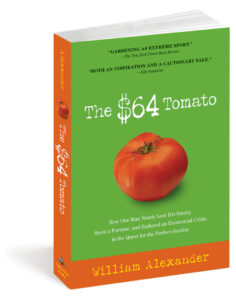 The $64 Tomato, by William Alexander. Alexander’s amusing take on gardening is evident in the title. He once calculated that, after all the landscape fees, soil importation, varmint and deer defenses, never mind buying seeds and plants and rigging up an irrigation system, he had spent $64 each for the delicious, decadent, heirloom Brandywine tomatoes he harvested one summer. Despite this sobering number, Alexander went on to expand his vegetable bed, install a meadow, add a new lawn and continue his hobby.
The $64 Tomato, by William Alexander. Alexander’s amusing take on gardening is evident in the title. He once calculated that, after all the landscape fees, soil importation, varmint and deer defenses, never mind buying seeds and plants and rigging up an irrigation system, he had spent $64 each for the delicious, decadent, heirloom Brandywine tomatoes he harvested one summer. Despite this sobering number, Alexander went on to expand his vegetable bed, install a meadow, add a new lawn and continue his hobby.
His humor is on every page, such as when discussing tools that are simply too short for many gardeners. “Anyone of average height… cannot stand up straight and comfortably use a hoe or a rake with a five-foot handle,” he writes. “This isn’t 1780, when people slept in those impossibly short beds you see in historic homes.”
Another memoir-style book, this is a fun read that can teach you. Alexander’s mistakes (planting Kentucky bluegrass between his raised garden beds, letting marigolds go to seed inadvertently) don’t have to be your mistakes. Enjoy his humor and gardening mishaps for yourself.
This is a great time of year to put down the hoe and rake and, instead, put your feet up, fix an iced tea (perhaps garnished with homegrown lemon or mint) and peruse these gardening books for inspiration and education. OS
A native Floridian and lifelong gardener, Belea spends her time off fostering cats and
collecting caladiums. You can send gardening questions or column suggestions to her at belea@magnoliamediaco.com


